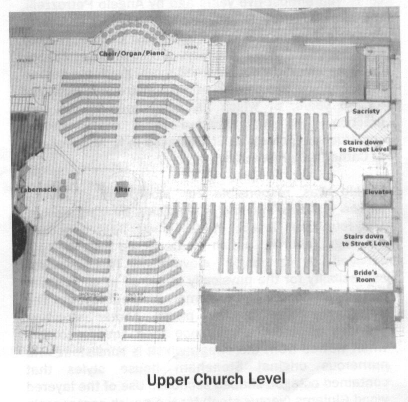Here's the plan for expanding my parish church in suburban Stoneham: the long rectangle on the left is the current nave, and the square on the right is the addition. The church interior will be reoriented, with the new sanctuary along what is now the left wall.

There are some good things about the design: the tabernacle will be restored to its rightful position on the center axis, whereas it is currently on a side altar. The setting of the organ console and choir in the former sanctuary puts them in an unobtrusive location.
On the downside, the wrap-around seating and the far-forward placement of the altar on its, um, peninsula are a disappointment. The design lacks a visibly distinct and well-defined sanctuary and nave, the classic symbol of divine-human encounter and of earth-to-heaven pilgrimage so suitable for the Holy Mass. The new church will be in some ways a missed opportunity.
Going by a recent parish newsletter, the celebrant's chair will not be on the center axis as this diagram depicts, but will be set to one side. That's a good change.

I suppose "I've seen worse" doesn't quite qualify as glowing praise...
I've seen worse.
It is always difficult to take an existing church and expand it. Yes, I have seen worse. I struggle with this in my new parish where I am challenged to double the size of the church. I as progress with this I am sure reports will be on my blog.
At least it's basically cruciform. Also, couldn't the sanctuary area be defined by height (steps) or other ways?
It probably will be defined by steps, but it's a weak delineation.
Consider an entrance procession: in the classic image, it passes among the people and moves up toward the altar: this is a sign of transcendence. In the design of this church, a procession arrives at the altar without ever moving beyond the people, and that sign value is lost.
Perhaps a communion rail would also help to define the sanctuary.
In St. Peter's basilica, the high altar is located in a similar way, and the "sanctuary" is "defined" primarily by height, isn't it?
... Upon a bit more reflection, it seems to me that the altar itself is the key "symbol of divine-human encounter."
... Which, to clarify, is not to say that there aren't more and less suitable architectural placements for the altar. But this one doesn't strike me as bad.
If this altar were sufficiently raised and accompanied by Bernini's famous columns and a domed baldachino, I guess that would compensate for what is lacking. As it stands, though, an opportunity to build up the symbols of transcendence has been missed.
But I'm a fair-minded guy; when the reconstruction is done in a few months, I'll be back with some real pictures. The current schedule aims to have it done by Christmas.